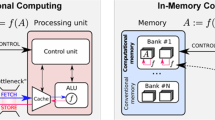Abstract
Built-in self-test (BIST) techniques modify functional hardware so that a chip has the capability to test itself. A prime concern in using BIST is the area overhead due to the modification of normal registers to BIST registers. This paper proposes register and interconnect assignment techniques that address the BIST area overhead issue during high-level synthesis. A minimal intrusion BIST methodology is employed where a subset of the functional registers are modified to be BIST registers. Depending on the BIST functions performed (test pattern generation and/or test response compression) and the concurrency of the functions, four types of BIST registers with varying costs are used. Data path allocation techniques are presented that (1) maximize the sharing of BIST registers between modules, and (2) minimize the number of expensive BIST registers that are essential for minimal intrusion BIST of a data path. The designs synthesized by our techniques have the same number of functional modules and registers as those synthesized using traditional approaches but require significantly lower BIST area overhead.
Similar content being viewed by others
References
L.J. Avra and E.J. McCluskey, “High-Level Synthesis of Testable Designs: An Overview of University Systems,” Proc. Test Synthesis Seminar, Intn'l. Test Conf., Oct. 1994, pp. 1–8.
P.R. Chalasani, S. Bhawmik, A. Acharya, and P. Palchaudhari, “Design of Testable VLSI Circuits with Minimum Area Overhead,” IEEE Trans. on Computers, Vol. 38, pp. 1460–1462, 1989.
G. Craig, C. Kime, and K. Saluja, “Test Scheduling and Control for VLSI Built-in Self-Test,” IEEE Trans. on Computers, Vol. 37, pp. 1099–1109, 1988.
S-P Lin, C.A. Njinda, and M.A. Breuer, “A Systematic Approach for Designing Testable VLSI Circuits,” Proc. Intn'l Conf. on Computer-Aided Design, Nov. 1991, pp. 496–499.
C. Papachristou, S. Chiu, and H. Harmanani, “A Data Path Synthesis Method for Self-Testable Designs,” Proc. 28th Design Automation Conf., June 1991, pp. 378–384.
H. Harmanani and C. Papachristou, “An Improved Method for RTL Synthesis with Testability Tradeoffs,” Proc. Intn'l Conf. on Computer-Aided Design, Nov. 1993, pp. 30–35.
L. Avra, “Allocation and Assignment in High-Level Synthesis for Self-Testable Data Paths,” Proc. Intn'l. Symp. on Circuits and Systems, Aug. 1991, pp. 463–472.
L. Avra and E.J. McCluskey, “Synthesizing for Scan Dependence in Built-In Self-Testable Designs,” Proc. Intn'l Test Conf., 1993, pp. 734–743.
I.G Harris and A. Orailoglu, “Microarchitectural Synthesis of VLSI Designs with High Test Concurrency,” Proc. 31st Design Automation Conf., June 1994, pp. 206–211.
I.G. Harris and A. Orailoglu, “SYNCBIST: SYNthesis for Concurrent Built-In Self-Testability,” Proc. Intn'l Conf. Comp. Design, Oct. 1994, pp. 101–104.
N. Mukherjee, M. Kassab, J. Rajski, and J. Tyszer, “Arithmetic Built-In Self-Test for High-Level Synthesis,” Proc. VLSI Test Symp., May 1995, pp. 132–139.
A. Orailoglu and I.G. Harris, “Microarchitectural Synthesis for Rapid BIST Testing,” IEEE Trans. on Computer-Aided Design, Vol. 16, No. 6, pp. 573–586, June 1997.
Data Book, G10-p Cell-Based ASIC Products. LSI Logic Corp., May 1996.
I. Parulkar, “Optimization of BIST Resources during High-Level Synthesis,” PhD thesis, Dept. of Electrical Engineering-Systems, Univ. of Southern California., Jan. 1998.
P. Michel, U. Lauther, and P. Duzy, The Synthesis Approach to Digital System Design, Kluwer Academic Publishers, 1992.
D. Gajski, N. Dutt, A. Wu, and S. Lin, High-Level Synthesis, Kluwer Academic Publishers, 1992.
G. D. Micheli, Synthesis and Optimization of Digital Circuits, McGraw-Hill, Inc., 1994.
I. Parulkar, S.K. Gupta, and M.A. Breuer, “Scheduling and Module Assignment for Reducing BIST Resources in Data Paths,” Proc. Design, Automation and Test in Europe, Feb. 1998.
B.M. Pangrle, “On the Complexity of Connectivity Binding,” IEEE Trans. on Computer-Aided Design, Vol. 10, pp. 1460–1465, 1991.
M.R. Garey and D.S. Johnson, Computers and Intractability: A Guide to the Theory of NP-Completeness, W.H. Freeman and Company, 1979.
M.C. Golumbic, Algorithmic Graph Theory and Perfect Graphs, Academic Press, 1980.
D.L. Springer and D.E. Thomas, “Exploiting the Special Structure of Conflict and Compatibility Graphs in High-Level Synthesis,” Proc. Intn'l Conf. on Computer-Aided Design, Nov. 1990, pp. 254–257.
F. Gavril, “Algorithms for Minimum Coloring, Maximum Clique, Minimum Covering by Cliques, and Maximum Independant Set of a Chordal Graph,” SIAM J. Computing, pp. 180–187, June 1972.
L.J. Avra, L. Gerbaux, J-C. Giomi, F. Martinolle, and E.J. McCluskey, “A Synthesis-for-Test Design System,” Tech. Report CSL TR 94–622, Computer Systems Laboratory, Stanford University, May 1994.
I. Parulkar, S.K. Gupta, and M.A. Breuer, “Introducing Redundant computations in a Behavior to Reduce BIST Resources,” Proc. 35th Design Automation Conf., June 1998, pp. 548–553.
Author information
Authors and Affiliations
Rights and permissions
About this article
Cite this article
Parulkar, I., Gupta, S.K. & Breuer, M.A. Allocation Techniques for Reducing BIST Area Overhead of Data Paths. Journal of Electronic Testing 13, 149–166 (1998). https://doi.org/10.1023/A:1008357805049
Issue Date:
DOI: https://doi.org/10.1023/A:1008357805049




